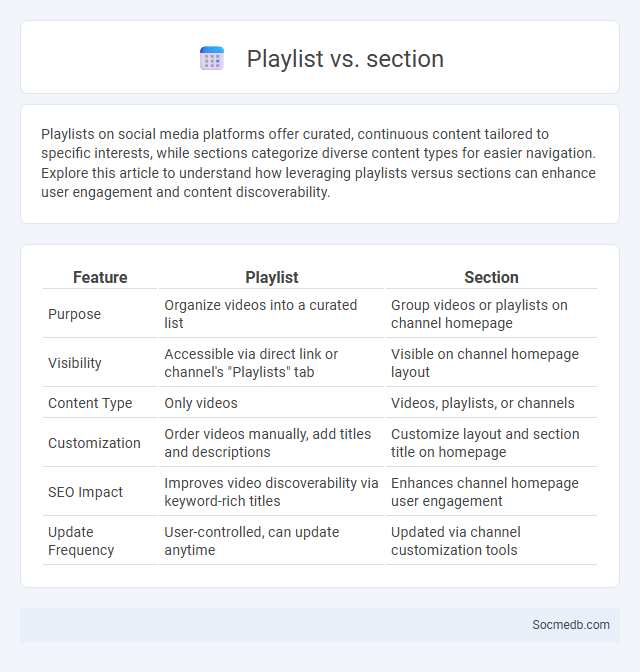
Photo illustration: playlist vs section
Playlists on social media platforms offer curated, continuous content tailored to specific interests, while sections categorize diverse content types for easier navigation. Explore this article to understand how leveraging playlists versus sections can enhance user engagement and content discoverability.
Table of Comparison
| Feature | Playlist | Section |
|---|---|---|
| Purpose | Organize videos into a curated list | Group videos or playlists on channel homepage |
| Visibility | Accessible via direct link or channel's "Playlists" tab | Visible on channel homepage layout |
| Content Type | Only videos | Videos, playlists, or channels |
| Customization | Order videos manually, add titles and descriptions | Customize layout and section title on homepage |
| SEO Impact | Improves video discoverability via keyword-rich titles | Enhances channel homepage user engagement |
| Update Frequency | User-controlled, can update anytime | Updated via channel customization tools |
Understanding Playlists, Sections, and Metadata
Understanding playlists, sections, and metadata on social media enhances your content organization and visibility. Playlists group related videos, improving user experience, while sections categorize content for easier navigation on your profile. Proper metadata, including titles, descriptions, and tags, boosts discoverability by aligning your content with relevant search queries and algorithms.
Key Differences Between Playlist, Section, and Metadata
Playlists organize content sequentially, allowing you to curate and control the viewing order, while sections group related content visually without imposing a fixed sequence. Metadata provides essential information about the content, such as tags, descriptions, and categories, enhancing discoverability and search optimization. Understanding these distinctions helps you efficiently manage and present social media content for maximum engagement.
Defining a Playlist: Purpose and Functionality
A playlist on social media serves as a curated collection of content designed to organize videos, music, or posts for easy access and seamless user experience. Its primary functionality includes enhancing content discovery, fostering engagement, and tailoring consumption to your interests or brand identity. Playlists enable users to efficiently navigate vast media libraries by grouping similar items, optimizing interaction and retention.
Section: Organizing Content for User Navigation
Effective organization of social media content enhances user navigation by categorizing posts into clear, intuitive sections such as trending topics, saved items, and personalized feeds. Utilizing metadata, hashtags, and content tagging improves discoverability and ensures users can easily find relevant posts aligned with their interests. Implementing structured navigation menus and search filters reduces user effort, increasing engagement and session duration on social platforms.
Metadata: Enhancing Discoverability and Context
Metadata in social media platforms plays a crucial role in enhancing content discoverability by providing structured information such as hashtags, geotags, and user tags that help algorithms categorize and recommend posts effectively. It adds contextual layers to posts, improving user engagement and enabling precise audience targeting through detailed insights like timestamps, device type, and location data. Accurate and comprehensive metadata supports advanced search capabilities and analytics, driving more relevant interactions and optimizing content visibility across diverse social networks.
Use Cases for Playlists, Sections, and Metadata
Playlists, sections, and metadata enhance social media content organization by enabling You to curate personalized experiences that boost engagement and discoverability. Playlists group related videos or posts, increasing viewer retention and facilitating thematic storytelling. Metadata, including tags and descriptions, improves search algorithms' accuracy, making Your content more accessible to targeted audiences.
Playlist vs Section: Content Grouping Strategies
Effective content grouping strategies on social media involve distinguishing between playlists and sections to optimize user engagement. Playlists organize related videos or posts into a sequential flow, enhancing user experience by guiding viewers through a curated journey, while sections categorize content into thematic clusters for easy navigation and quick access. You can leverage playlists to encourage continuous viewing and use sections to showcase diverse content types, improving discoverability and retention.
Metadata’s Role in Content Management Systems
Metadata plays a crucial role in social media content management systems by organizing and categorizing posts, enhancing searchability, and improving user engagement metrics. Accurate metadata tagging allows Your content to be efficiently indexed, making it easier for algorithms to recommend relevant posts to targeted audiences. Proper metadata integration ensures streamlined content discovery, boosting visibility and interaction across social media platforms.
Best Practices for Implementing Playlists, Sections, and Metadata
Implementing playlists, sections, and metadata effectively on social media platforms enhances content discoverability and user engagement by organizing videos into thematic groups and improving search relevance. Optimizing metadata with accurate titles, descriptions, and relevant keywords ensures higher ranking in search algorithms and attracts targeted audiences. Consistent use of sections and playlists drives longer viewer retention, encourages binge-watching behavior, and simplifies navigation across a channel's content library.
Choosing the Right Structure: Playlist, Section, or Metadata?
Choosing the right structure for organizing social media content hinges on the platform's capabilities and the audience's interaction preferences. Playlists offer sequential viewing ideal for tutorials or thematic series, while sections allow categorization of varied content types for easier navigation. Metadata enhances discoverability through keywords and tags, boosting engagement by aligning content with user search intent and trends.
 socmedb.com
socmedb.com